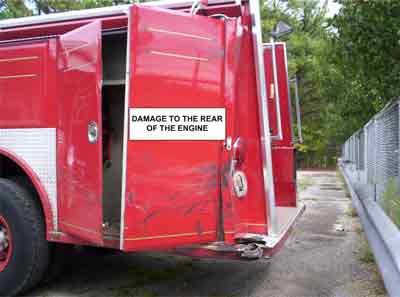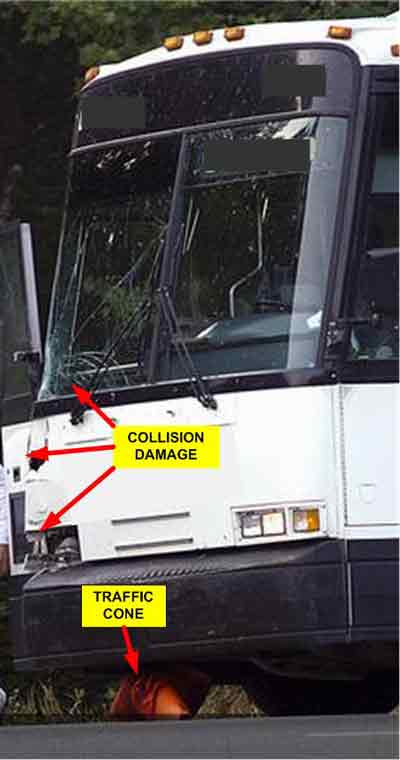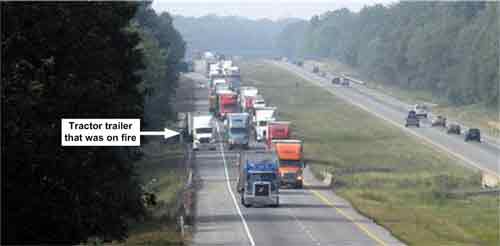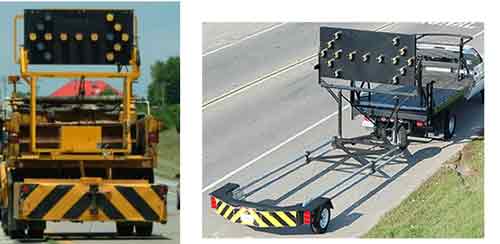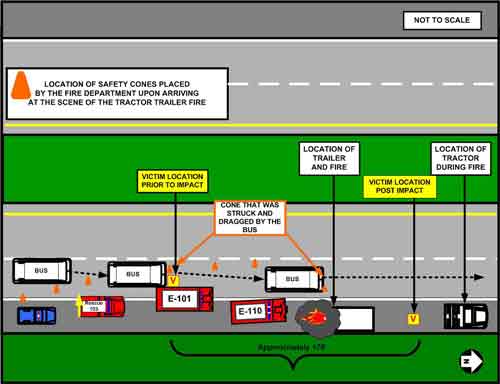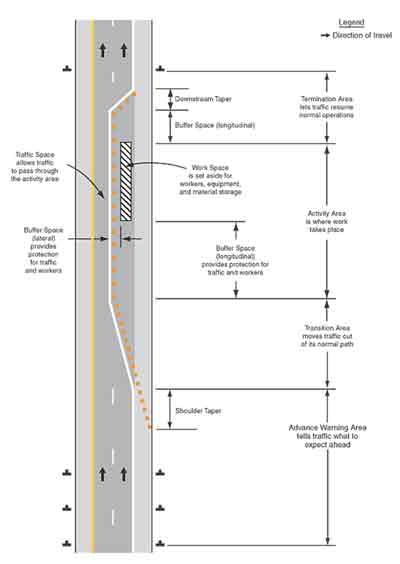Volunteer Fire Fighter Dies When Struck By a Bus While Working Along an Interstate Highway - Illinois
 Death in the Line of Duty…A summary of a NIOSH fire fighter fatality investigation
Death in the Line of Duty…A summary of a NIOSH fire fighter fatality investigation
F2007-26 Date Released: December 23, 2009
SUMMARY
During the early morning darkness of Friday, July 27, 2007, a 43-year-old male volunteer fire fighter was struck by a passenger bus while clearing the scene of a tractor trailer fire that had occurred along an interstate highway. The bus was traveling in the traffic lane adjacent to the incident scene. It failed to move to the left to avoid the parked emergency vehicles in spite of traffic cones, an illuminated directional arrow, and flashing emergency lights warning of an active emergency scene. The bus sideswiped a parked engine and struck the victim as he was placing rolled fire hose into the driver’s side storage compartment. The victim was pronounced dead at the scene by the county coroner. The key contributing factor identified in this investigation was the bus driver’s failure to slow down and move over while passing a highway emergency work zone.
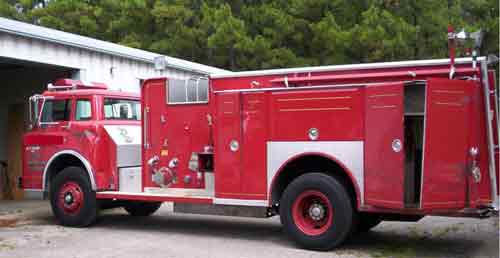 |
|
Apparatus involved in the incident
NIOSH photo |
The NIOSH investigator concluded that to minimize the risk of similar occurrences, fire departments should:
- establish pre-incident plans regarding traffic control for emergency service incidents and pre-incident agreements with public safety agencies, traffic management organizations, and private sector responders
- develop all-inclusive standard operating procedures (SOPs) for responding to highway incidents with specific guidance on positioning apparatus to protect emergency workers from oncoming traffic when entering or exiting parked vehicles, working pump panels, and retrieving or replacing equipment from apparatus storage areas
- ensure that high visibility chevrons and reflective markings are applied to all apparatus to enhance conspicuity while parked at emergency scenes and during emergency response
- ensure that SOPs include guidance on establishing advance warning and transition areas, and consider the use of an upstream monitor for highway-related incidents
- ensure that fire fighters wear suitable high-visibility retro-reflective apparel while working non-fire emergency scenes near moving traffic
Additionally, governing authorities having jurisdiction should:
- consider enacting, or enhance existing, “Slow Down, Move Over” legislation to include provisions that will help protect emergency responders who are working near moving traffic at highway emergency work zones
- consider adopting “intelligent transportation systems (ITS)” and incorporate “slow down, move over” verbiage into crash warning messages that are broadcast on the national ITS (511) system
Additionally, commercial passenger bus manufacturers should:
- consider incorporating crash avoidance systems into design specifications for passenger buses
INTRODUCTION
On July 27, 2007, a 43-year-old male volunteer fire fighter (the victim) was struck and killed by a commercial passenger bus that was traveling past the scene of a tractor trailer fire along an interstate highway. On July 30, 2007, the U.S. Fire Administration notified the National Institute for Occupational Safety and Health (NIOSH), Division of Safety Research (DSR) of this incident. On September 24, 2007, an investigation of this incident was conducted by a Safety and Occupational Health Specialist from the NIOSH Fire Fighter Fatality Investigation and Prevention Program. Meetings and interviews were conducted with the chief of the department, fire department officers, fire fighters, police, and emergency personnel who were present at the scene. The NIOSH investigator visited and took photos of the incident scene. Copies of the State Department of Labor report, the Illinois State Police crash reconstruction report, the department’s SOPs, training records, witness statements, death certificate, and police incident scene diagrams and photographs were reviewed by the NIOSH investigator.
FIRE DEPARTMENT
The volunteer fire department involved in this incident serves a population of approximately 5,300 residents in an area of approximately 110 square miles of mostly small rural communities and farm land. It is responsible for approximately 6 miles of interstate highway and responds to an average of 20 to 30 incidents on the interstate per year. The fire department maintains two stations that are staffed by approximately 22 volunteer fire fighting personnel.
Department SOPs included highway response procedures; however, a more clearly defined description of procedures for responding to highway incidents would be beneficial to enhance the safety of all emergency responders working at the incident scene.
TRAINING and EXPERIENCE
The state where the incident occurred does not have a mandatory fire fighter certification program for volunteers, but departments may utilize the State Fire Service Institute program which meets requirements for the National Fire Protection Association (NFPA) 1001 Firefighter I and II. The classroom portion of this training is provided in a web-based on-line format. Upon successful completion of the cognitive requirements, students may complete the practical modules through their individual departments or at the State Fire Service Institute Training Academy.
The victim had served 22 years as a volunteer fire fighter with this department. He had not achieved certification through the State Fire Service Institute program. However, throughout his 22 years with the department, he had successfully completed the department’s monthly training sessions which included apparatus operations, vehicle extrication, water shuttle and hose hook-up, hazardous materials, tanker and engine operations, confined space, first aid, and cardio pulmonary resuscitation.
PERSONNEL, CLOTHING, AND PERSONAL PROTECTIVE EQUIPMENT
There were nine fire department personnel on the scene when the incident occurred: two engines with five fire fighters, a rescue truck with two fire fighters and a safety officer. The department officer’s car (a sport utility vehicle) was driven by the chief and one fire fighter arrived via his personal vehicle (POV). Fire fighters were wearing full bunker gear and boots while working the trailer fire. Retro-reflective vests were not being worn.
VEHICLES INVOLVED
The fire apparatus that was struck by the bus was a 1989 engine. Following the incident there was contact damage on the driver’s side rear panel, step and side door (Photo 1). The bus was a 1998 tri-axle commercial passenger motorcoach that was equipped with an automatic transmission. The interior seating area included two passenger seats on either side of a center aisle from behind the driver to the rear of the bus. Following the incident, contact damage was visible on the side front bumper, headlight, grill, windshield, rear fender molding, and the second axle tire and rim (Photo 2).
TIMELINE
Note: This timeline is a summary of events that occurred as the incident evolved. Not all events are included in this timeline. The times are approximate and were obtained by studying the dispatch records, witness statements, and other available information. In some cases, the times are rounded to the nearest minute.
The response, listed in order of arrival (all times are approximate) and events, include:
- 0249 Hours
The fire department was dispatched to a truck fire along the interstate highway. - 0306 Hours
Four fire department vehicles reported on the scene at approximately the same time. All vehicles were equipped with emergency lighting that remained in operation from arrival to departure following the incident. The fire department units on the scene were (Diagram 1):- Unit #103, a rescue truck, with a fire fighter and a safety officer parked on the highway shoulder. Unit #103 was equipped with a lighted directional arrow board that was in operation at the time of the incident.
- Engine #101 with two fire fighters and the victim parked just ahead of 103 straddling the fog line and about 6 feet into the driving lane.
- Engine #110 with three fire fighters parked on the fog line ahead of #101.
- The chief’s SUV was parked behind Unit #103 and the POV was behind the SUV.
- 0414 Hours
The victim was struck and killed by the bus as he was placing hose into the storage compartment near the front of Engine 101.
WEATHER AND ROAD CONDITIONS
The area where the incident occurred was a state maintained north/south, four lane interstate highway that had two lanes available for traffic in each direction. The asphalt surface was in good condition with the outside perimeter marked by solid white fog lines and the travel lanes divided by intermittent white lines. The north/south lanes were separated by a grass median and bordered by asphalt shoulders on both sides (Photo 3). The area of highway where the incident occurred had no artificial lighting. At the time of the incident the roadway was dry and there was no obstruction or debris in the roadway. The temperature was ~73º with humidity at 73%. It was dark and the skies were clear. There was a negligible wind at less than 5 miles per hour (MPH). Neither the weather nor the road conditions appeared to be a factor in this incident.
PERTINENT INCIDENT CITATION INFORMATION
The conclusion of the State Department of Labor investigation was that, “this accident was totally unavoidable due to the uncontrollable action of the driver of the bus.” The police report concluded that:
- There was no view obstruction of the emergency equipment that was extinguishing the tractor trailer fire.
- Emergency equipment on the scene had emergency lights activated and all were in operation.
- At the time of the crash, vehicle traffic was light in the area of the incident site.
- An inspection of the bus and driver’s log revealed no violations that would have made the driver unsafe for service.
- The bus driver had over six years of commercial driving experience so experience should not have been a factor.
- The primary cause in this crash was the bus driver’s failure to change lanes when approaching emergency vehicles which is a violation of the State Vehicle Code. The bus driver was issued a citation for the offense.
INVESTIGATION
On July 27, 2007, at approximately 0249 hours, the local volunteer fire department was dispatched to a reported tractor trailer fire along an interstate highway. Upon arrival at the scene, fire fighters found a tractor trailer that was parked on the right shoulder. Flames were visible from under the rear axle area of the trailer. The driver of the truck told fire fighters that the brakes on the trailer had locked and overheated. He had attempted to extinguish the flames with a portable fire extinguisher, but was not successful. The tractor had been disconnected from the trailer and was parked approximately 500 feet north. Dispatch informed the chief that the nearest law enforcement unit was approximately one hour travel time from the scene. Due to the early morning time of the incident traffic was very light in the area, so the chief advised dispatch that additional traffic management was not immediately required but he would monitor the situation and request help if needed.
Upon arriving at the scene, fire fighters positioned their apparatus in an attempt to create a safe zone in which to work while extinguishing the fire. They placed six 28 inch traffic cones at an angle to create a visual barrier of the emergency work zone (Diagram 1). All emergency vehicles on the scene were equipped with emergency lights, including a directional arrow that was operating on the back of Unit 101. All lights remained in operation during the entire incident including clearing the scene and clean-up.
Approximately one hour after their arrival, fire fighters had extinguished the fire and completed overhaul. They had begun to clear the area and return the tools and equipment to the fire trucks. Immediately prior to being struck by the bus, the victim was standing next to Engine 101 and was in the process of returning fire hose to the storage compartment that was located on the driver’s side near the front of the engine (Diagram 1). A passenger on the bus reported seeing the emergency lights as they approached the incident scene and expressed concern to another passenger that the driver was not pulling over. In her statement, she surmised that the driver may have fallen asleep. When interviewed, the driver had no definitive explanation of what caused him to crash into the fire engine, but the facts are that he did not heed the emergency warning lights or traffic cones and failed to yield one full traffic lane or reduce speed upon approaching the emergency scene. The result was that the bus sideswiped Engine 101 striking the driver’s side rear panel, step, side door and the victim, and continued travelling northbound for approximately one-half mile before pulling over onto the right shoulder of the highway. Due to the force of the impact, the victim was found approximately 170 feet from where he had been standing. Fire fighters on the scene immediately attempted life saving measures but were unsuccessful. The victim was pronounced dead at the scene.
CONTRIBUTING FACTORS
Occupational injuries and fatalities are often the result of one or more contributing factors or key events in a larger sequence of events that ultimately result in the injury or fatality. NIOSH investigators identified the following item as a key contributing factor in this incident that ultimately led to the fatality:
- Failure of the bus driver to slow down and move over while passing a highway emergency work zone.
This line-of-duty death provides a reminder that emergency responders can never depend on lights, signs, flares or cones to protect them when they are working near moving traffic. Fire departments need to ensure that multiple prevention strategies are in place and emergency responders must maintain an awareness of what is going on around them at all times. Fire departments should train members on how to identify and pre-plan an escape strategy should they encounter a dangerous traffic situation such as a vehicle entering the emergency work zone.
CAUSE OF DEATH
According to the County Coroner’s report, the victim died from multiple blunt force injuries.
RECOMMENDATIONS
Recommendation #1: Fire departments should establish pre-incident plans regarding traffic control for emergency service incidents and pre-incident agreements with public safety agencies, traffic management organizations, and private sector responders.
Discussion: Pre-incident planning is fundamental to effective traffic control and management. In A White Paper: Protecting Emergency Responders on the Highways,1 a preplan should: (1) account for possible use of detours; (2) anticipate the likelihood of vehicles transporting hazardous materials or of extraordinary weight or size; (3) accommodate the need to keep commerce flowing; (4) minimize the possibility of secondary incidents; and (5) account for possible impact on neighboring jurisdictions.
According to the US Fire Administration document, Traffic Incident Management Systems, 2 specific concepts that should be addressed in pre-incident planning for roadway incident operations include the following:
- all agencies that may respond to roadway incidents should be fully involved in the process, formatting and developing of the plan, and ensure that the final plan is easily understood and implemented within their agency
- each agency involved must provide initial and refresher training, and ensure that individual and organizational roles are understood
- each agency should make sure that personnel are at least minimally briefed on the roles and procedures of other plan participants to avoid on-scene confusion and conflict.
In this incident, neither the department of transportation or law enforcement was on the scene to assist with traffic management. It was reported that when contacted, the nearest law enforcement unit was approximately one hour travel time from the scene. Due to the time of the incident being in the early morning hours, traffic was very light in the area. The decision was made by the department that due to the minimal traffic, and the minor scope of the incident, additional traffic management was not immediately needed. They decided to continually re-evaluate and request help if necessary. Although the department took a number of prudent highway incident safety measures, there are several additional procedures that could have been considered to further enhance the safety of the emergency work zone.
It is possible that an upstream police vehicle could have alerted the bus driver or warned the victim, or a properly positioned highway department truck that was equipped with a large flashing directional arrow and truck mounted attenuatora (Photo 4) could have absorbed the impact of the bus prior to striking the victim. Additional traffic control resources should be summoned at all times when a fire department goes in service on a highway incident that is expected to involve a substantial period of time.
States and municipalities, including the transportation department, in conjunction with fire departments, emergency medical responders, law enforcement, and private sector responders (i.e. tow truck operators) should develop pre-incident plans that include automatic response protocols for highway emergency scenes. Governing entities should ensure that adequate funding is available to staff and equip emergency response protocols once jointly established and agreed upon by all parties involved.
a A truck mounted attenuator is a portable impact attenuator attached to the rear of a large truck. It is used as a shield to prevent errant vehicles from entering a highway work zone. They are frequently used in short-term or mobile work zones.
Recommendation #2: Fire departments should develop all-inclusive standard operating procedures (SOPs) for responding to highway incidents with specific guidance on positioning apparatus to protect emergency workers from oncoming traffic when entering or exiting parked vehicles, working pump panels, and retrieving or replacing equipment from apparatus storage areas.
Discussion: Although it may be impossible to ensure emergency workers are protected from every danger that is presented by traffic moving past an emergency work zone, there are proactive things that can be done to mitigate known hazards.3 Department SOPs should outline methods that can be followed based on pre-incident planning for responding to specific incidents. An issue that the SOPs should address is the location of the tools, equipment, and hose storage within the apparatus. It may be possible to relocate the items to prevent personnel from always being exposed to oncoming traffic when they are retrieving or replacing them. If relocating the items is not feasible, a response strategy could be developed that would position apparatus so that personnel performing these duties would operate in an area that is protected from approaching traffic. Pre-incident planning is crucial in determining response strategies that provide optimum protection for on-scene emergency responders.4
In this incident, the victim was replacing hose in a compartment that was located on the driver’s side near the front of the apparatus, and by doing so he was exposed to passing traffic (Diagram 1). Although the department took prudent avoidance strategies, there was no physical barrier to protect the victim from being struck by a passing vehicle. Departments should make every effort to establish emergency work zones in accordance with MUTCD guidelines (Diagram 2) and, when feasible, ensure that all tasks responders are required to perform can be done within an area that is protected from moving traffic by a physical barrier.
Recommendation #3: Fire departments should ensure that high visibility chevrons and reflective markings are applied to all apparatus to enhance conspicuity while parked at emergency scenes and during emergency response.
Discussion: Highway incident scene safety has been at the forefront of efforts to reduce fire fighter death and injury. Several initiatives to increase conspicuity of emergency apparatus have been finalized and guidance has been provided to assist fire departments in implementing these procedures.2, 5 NFPA 1901, Standard for Automotive Fire Apparatus, was revised and became effective in January 2009. Its purpose is to enhance visibility of emergency vehicles that are parked along roadways during emergency incidents. Chapter 1.3.1 states that “ This standard shall apply to new fire apparatus that meet the following criteria: (1) That have 10,000 lb (4500 kg) or greater gross vehicle weight rating (GVWR) or are trailers intended to be towed by fire apparatus under emergency response conditions. (2) That are designed for use under emergency conditions to transport personnel and equipment and to support the suppression of fires and mitigation of other hazardous situations, or (3) That are contracted for on or after January 1, 2009.” The specific marking requirements are outlined in NFPA 1901 Chapter 15.9.3.1 and 15.9.3.2 which state that “A retro-reflective stripe(s) shall be affixed to at least 50 percent of the cab and body length on each side, excluding the pump panel areas, and at least 25 percent of the width of the front of the apparatus. The stripe or combination of stripes shall be a minimum of 4 inches (100 mm) in total width. At least 50 percent of the rear-facing vertical surfaces, visible from the rear of the apparatus, excluding any pump panel areas not covered by a door, shall be equipped with retro-reflective striping in a chevron pattern sloping downward and away from the centerline of the vehicle at an angle of 45 degrees.”6
Roadway incident response safety procedures call for fire apparatus to park on an angle at roadway incident scenes to create a work area that is protected from passing traffic. Often apparatus emergency lighting is not as effective when parked at an angle. A more effective design calls for emergency lights to be mounted up high on the back of the apparatus to provide 360º visibility. There is evidence that amber lighting on the rear of apparatus can be very effective at warning motorists of an active emergency work zone. Amber lights convey a message of caution and motorists are accustomed to slowing down for amber warning lights in highway construction work zones.7
As is the case with many volunteer fire departments, this department has an aging fleet. The apparatus involved in this incident was a 1989 engine that did not have retro-reflective markings. However the rescue unit that was parked to the rear of the apparatus was equipped with a lighted directional arrow that was in operation at the time of the incident (Diagram 1). NFPA 1901 applies to newly manufactured apparatus and is not retroactive. In many cases it can be cost effective and easy to retrofit existing vehicles to improve fire fighter emergency work zone safety. Fire departments should consider putting reflective tape on apparatus to mark doors, fixed sections that are not blocked by doors or ladder racks, and also down low around the bottom of the apparatus. A video detailing guidance for retrofitting apparatus with the newly recommended safety lighting and markingsexternal icon can be found by accessing the Emergency Responder Safety Institute website, http://www.respondersafety.com/MarkedAndSeen.aspx. 7
Recommendation #4: Fire departments should ensure that SOPs include guidance on establishing advance warning and transition areas, and consider the use of an upstream monitor for highway-related incidents.
Discussion: According to Lindsey and Patrick,“Emergency Vehicle Operations,” wwhen providing traffic control during limited-access highway operations, fire departments should consider assigning a member to monitor approaching traffic and activate an emergency signal if the actions of a motorist do not conform to established traffic control measures that are in place at the incident scene.8 Traffic control assistants should be identified by the department in advance, and training that is specific to the functions of the position should be provided. A traffic control assistant training programexternal icon can be found by accessing the Responder Safety Institute website, http://www.respondersafety.com/DownloadCategories/Training.aspx.9 (Link updated 4/9/2013) In this incident, it is possible that a traffic monitor who was watching on-coming traffic could have alerted the victim in time for him to move clear of the impact area.
NFPA 1500 Standard on Fire Department Occupational Safety and Health Program recommends that fluorescent and retro-reflective warning devices such as traffic cones, signs and illuminated warning devices, such as highway flares, be used to warn oncoming traffic of an emergency work zone.10 The Manual of Uniform Traffic Control Devices (MUTCD) designates fluorescent pink with black text as the best color for warning signs to identify active emergency work zones.11 Warning signs, flares and cones can improve the identification of fire apparatus, personnel and the emergency work zone. Flares used in conjunction with traffic cones with reflective collars can be very effective at channeling traffic around an incident scene. For emergency work zone identification, the cones should be a minimum of 28 inches high and preferably 36 inches high with two reflective bands.1 A model SOP for establishing advance warning and transition areas at highway-related incidentsexternal icon can be found at http://www.respondersafety.com/Articles/Model_SOG_Available_for_Download_on_Deploying_Cones
_and_flares_at_Roadway_Incidents.aspx. 12
In this incident, the department had placed six 28 inch orange emergency cones around the scene to provide a taper to redirect traffic. Several of these cones were struck by the bus, and one was found wedged under the front of the bus when it came to a stop approximately one-half mile from the initial impact. It is possible that additional flares or reflective signage further upstream may have alerted an attentive driver in time to avoid striking an emergency responder under similar circumstances. However, the fact that the bus driver ignored all of the warning lights and cones that the department had utilized provides evidence that, for whatever reason, he was not responding to visual stimuli.
This line-of-duty death provides a reminder that emergency responders can never depend on lights, signs, flares or cones to protect them when they are working near moving traffic. Fire departments need to ensure that multiple prevention strategies are in place and emergency responders must maintain an awareness to what is going on around them at all times. Fire departments should train members on how to identify and pre-plan an escape strategy should they encounter a dangerous traffic situation such as a vehicle entering the emergency work zone.
Recommendation #5: Fire departments should ensure that fire fighters wear suitable high-visibility retro-reflective apparel while working non-fire emergency scenes near moving traffic.
Discussion: To meet minimum requirements for high visibility apparel, responders should only use vests that meet a Class II requirement of ANSI/ISEA 107-2004 or the requirements of ANSI/ISEA 207-2006 for Public Safety Vests. These minimum requirements include 1) use of fluorescent background material 2) the fluorescent material may be yellow-green, orange-red, or red 3) retro-reflective material arranged for 360 degree visibility and 4) the garments should be labeled as compliant with ANSI/ISEA 107-2004 or ANSI/ISEA 207-2006. Federal Regulation 23 CFR 634 states, “The purpose of the regulations in this part is to decrease the likelihood of worker fatalities or injuries caused by motor vehicles while working within the right-of-way on Federal-aid highways.”13 NFPA 1500 8.7.10 states, “when members are operating at a traffic incident and their assignment places them in potential conflict with motor vehicle traffic, they shall wear a garment with fluorescent and retro-reflective material visible from all directions.10
Due to the fact that the fire fighters were attending to a working truck fire, they were not wearing retro-reflective vests at this emergency incident scene. However, all responders who are not involved in fire suppression activities should be wearing ANSI approved high visibility garments when working near moving traffic and don the retro-reflective vests during scene clean-up following extinguishment.
Recommendation #6: Governing authorities having jurisdiction should consider enacting, or enhance existing, “Slow Down, Move Over” legislation to include provisions that will help protect emergency responders who are working near moving traffic at highway emergency work zones.
Discussion: Slow-down, move-over laws require motorists who are traveling on multi-lane roadways to, when practical, merge away from an emergency vehicle working on the side of the highway to provide an empty travel lane of safety for the emergency responder. If not practical (due to road design or traffic volume) the motorist must slow down significantly below the posted speed limit while passing the emergency work zone. Model language for a “Slow-Down, Move-Over” law includes a provision that if a violation of the move over law results in a catastrophic injury or death to another person, in addition to any other penalty imposed by law, the violator’s driver’s license shall be suspended for a period of at least one year but not more than five years, and sentenced up to one year in jail.14
According to the Governors Highway Safety Association,15 all states have laws that increase the penalties for speeding or committing traffic violations when traveling in a highway construction work zone. Often monetary fines that are imposed for traffic violations that are committed outside of a construction zone will be doubled if those same traffic violations occur within a highway construction zone when workers are present or signs are posted. Twenty-six states double the fine for speeding or committing other traffic violations in a highway work zone. Thirty-four states have increased fines only for speeding. The remainder increase fines for speeding and other traffic violations. Twenty-four states require workers to be present in the construction zone for the increased penalties to take effect.15
Emergency responders who are operating at an incident scene where they are exposed to moving traffic are working in a “highway emergency work zone.” They are always present when there is a highway emergency incident and are possibly less able to concentrate on their surroundings than highway construction personnel due to intense life and death situations and the nature of their work. To promote a comparable level of awareness and help protect emergency responders while working at highway emergency scenes, governing authorities should consider enacting legislation, similar to highway construction work zone laws, that includes increased monetary penalties for traffic violations committed within an emergency work zone.
Recommendation #7: Governing authorities having jurisdiction should consider adopting “Intelligent Transportation Systems (ITS)” and incorporate “slow down, move over” verbiage into crash warning messages that are broadcast on the national ITS (511) system.
Discussion: On July 21, 2000 the Federal Communications Commission (FCC) designated “511” as the single traffic information telephone number to be made available to states and local jurisdictions across the United States. It is known as “America’s traveler information telephone number.” The FCC ruling left implementation issues and schedules to state and local agencies and telecommunications carriers. Many states have enacted the 511 traveler information telephone number to include traffic conditions including accidents, highway construction updates, weather and road conditions and alerts.16
When travelers are alerted to an emergency highway incident through the 511 notification system, a brief statement that would include verbiage such as “please be alert to emergency workers and remember to slow down and move over when you are passing an emergency incident scene” would be a timely reminder and increase drivers’ awareness of the upcoming emergency activity. Governing entities should consider including stipulations for such announcements when implementing a 511 traveler information system.
Recommendation #8: Commercial passenger bus manufacturers should consider incorporating crash avoidance systems into design specifications for passenger buses.
Discussion: In 2007 the National Highway Traffic Safety Administration (NHTSA) conducted a comprehensive review of motorcoach safety issues. Included in the review were several crash prevention efforts underway for heavy truck applications that could be applicable to motorcoaches in the future. These crash avoidance technologies include Lane Departure Warning (LDW), Forward Collision Warning (FCW) and Adaptive Cruise Control (ACC) systems. 17
A lane departure warning system is a mechanism designed to warn drivers when their vehicle begins to move out of its travel lane (unless a turn signal is activated for that direction). LDW systems have been available for use by commercial trucking fleets for several years. Forward collision warning systems are in-vehicle electronic systems that monitor the roadway in front of the host vehicle and warn the driver when a potential collision risk exists. FCW systems have been available for use by commercial passenger fleets for several years.
In a 2007 large scale field operational study completed by NHTSA, the effectiveness of several crash warning systems, including FCW and ACC, was tested to assess their effectiveness. The study provided preliminary indications that crash reduction of about 28% would result from application of these technologies, with about 21% of the reduction due to the FCW system. Analysis of real-world crashes are underway to see if these preliminary findings hold true and translate to the broader crash population. Potential applicability to motorcoaches will be considered in conjunction with requirements for heavy truck applications. 17 Passenger bus manufacturers should consider including these applications into motorcoach design specifications.
REFERENCES
- Protecting Emergency Responders on the Highways.external icon Responder Safety Institute website: http://www.respondersafety.com/DownloadCategories/White_Papers.aspx. Date accessed: August 2009.
- US Fire Administration [2008]. Traffic Incident Management Systems. Emmitsburg, MD: Federal Emergency Management Agency, US Fire Administration.
- NIOSH [2001]. NIOSH Hazard ID: Traffic Hazards to Fire Fighters While Working Along Roadways. Cincinnati, OH: U.S. Department of Health and Human Services, Public Health Service, Centers for Disease Control and Prevention, National Institute for Occupational Safety and Health, DHHS (NIOSH) Publication No. 2001-143.
- Sullivan J [2009]. Innovations In Apparatus Conspicuityexternal icon http://www.firerescue1.com/print.asp?act=print&vid=508854 Date accessed: July 2009.
- Austin S [2009]. Marked and Seen – Rear Apparatus Visibilityexternal icon http://www.firerescue1.com/print.asp?act=print&vid=498240 Date accessed: June 2009.
- NFPA [2009]. NFPA 1901, Standard for automotive fire apparatus. Quincy, MA: National Fire Protection Association.
- Marked and Seenexternal icon, Emergency Responder Safety Institute website, http://www.respondersafety.com/MarkedAndSeen.aspx . Date accessed: July 2009.
- Lindsey, J, Patrick, R [2007]. Emergency vehicle operations. Upper Saddle River, NJ: Pearson Prentice Hall, Chapter 9.
- Developing Traffic Assistant Control Programs.external icon Emergency Responder Safety Institute website: http://www.respondersafety.com/DownloadCategories/Training.aspx Date accessed: September 2009. (Link updated 4/9/2013)
- NFPA [2007]. NFPA 1500, Standard on fire department occupational safety and health program. Quincy, MA: National Fire Protection Association.
- FHWA [2009]. Manual on Uniform Traffic Control Devices.external icon Washington, DC: U.S. Department of Transportation, Federal Highway Administration (FHWA). http://mutcd.fhwa.dot.gov/htm/2009/html_index.htm. Date accessed: December 2009.
- Model Standard Operating Guideline (SOG) for Cone, Flare, or Sign Deployment at Traffic-related Incidents.external icon Responder Safety website: http://www.respondersafety.com/Articles/Model_SOG_Available_for_Download_on_Deploying_Cones_and_Flares_at_Roadway_Incidents.aspx. Date accessed: November 2009.
- Be Right Be Brightexternal icon. Emergency Responder Safety Institute website: http://www.respondersafety.com/BeRightBeBright.aspx. Date accessed: July 2009.
- Model Language for a Move Over Law.external icon Responder Safety Institute website: http://www.respondersafety.com/About-Us/Key-Initiatives/Move-Over-Law/Default.aspx?qs=922732E8F28CA3BD62BB6C30A2A34DAE86055B69B3B687AE Date accessed: June 2009. (Link updated 5/13/2015)
- Work Zone Speed Limit Laws.external icon Governors Highway Safety Association website: http://www.ghsa.org/html/stateinfo/laws/sanctions_laws.html Date accessed: June 2009.
- America’s Traveler Information Telephone Number, What Is It?external icon U.S. Department of Transportation, Federal Highway Administration website: http://www.fhwa.dot.gov/trafficinfo/511what.htm Date accessed: August 2009.
- NHTSA’s Approach to Motorcoach Safety. U.S. Department of Transportation, National Highway Traffic Safety Administration website: http://www.nhtsa.gov/staticfiles/DOT/NHTSA/Vehicle%20Safety/Articles/Associated%20Files/481217.pdf Date accessed: September 2009. (Link Updated 8/16/2012 – no longer available 1/8/2013)
INVESTIGATOR INFORMATION
This investigation was conducted and the report was authored by Virginia Lutz, Safety and Occupational Health Specialist, with the NIOSH, Fire Fighter Fatality Investigation and Prevention Program, Surveillance and Field Investigations Branch, Division of Safety Research, NIOSH. An expert technical review was provided by Steve Austin, Emergency Responder Safety Institute.
ADDITIONAL INFORMATION
In response to this fatality, there was a campaign in the state where the incident occurred to pass a law that, among other provisions, would permit on-scene fire personnel to close a highway and re-route traffic around an emergency work zone. This effort was successful and “Shib’s Lawexternal icon” was enacted on January 1, 2009. A full text of the law can be found at http://www.ilga.gov/legislation/fulltext.asp?DocName=&SessionId=51&GA=95&DocTypeId=SB&DocNum=2488&GAID=9≤gID=36686&SpecSess=&Session
PHOTOS AND DIAGRAMS
|
The National Institute for Occupational Safety and Health (NIOSH), an institute within the Centers for Disease Control and Prevention (CDC), is the federal agency responsible for conducting research and making recommendations for the prevention of work-related injury and illness. In fiscal year 1998, the Congress appropriated funds to NIOSH to conduct a fire fighter initiative. NIOSH initiated the Fire Fighter Fatality Investigation and Prevention Program to examine deaths of fire fighters in the line of duty so that fire departments, fire fighters, fire service organizations, safety experts and researchers could learn from these incidents. The primary goal of these investigations is for NIOSH to make recommendations to prevent similar occurrences. These NIOSH investigations are intended to reduce or prevent future fire fighter deaths and are completely separate from the rulemaking, enforcement and inspection activities of any other federal or state agency. Under its program, NIOSH investigators interview persons with knowledge of the incident and review available records to develop a description of the conditions and circumstances leading to the deaths in order to provide a context for the agency’s recommendations. The NIOSH summary of these conditions and circumstances in its reports is not intended as a legal statement of facts. This summary, as well as the conclusions and recommendations made by NIOSH, should not be used for the purpose of litigation or the adjudication of any claim. For further information, visit the program website at www.cdc.gov/niosh/fire or call toll free 1-800-CDC-INFO (1-800-232-4636).
|
This page was last updated on 01/28/2010.

